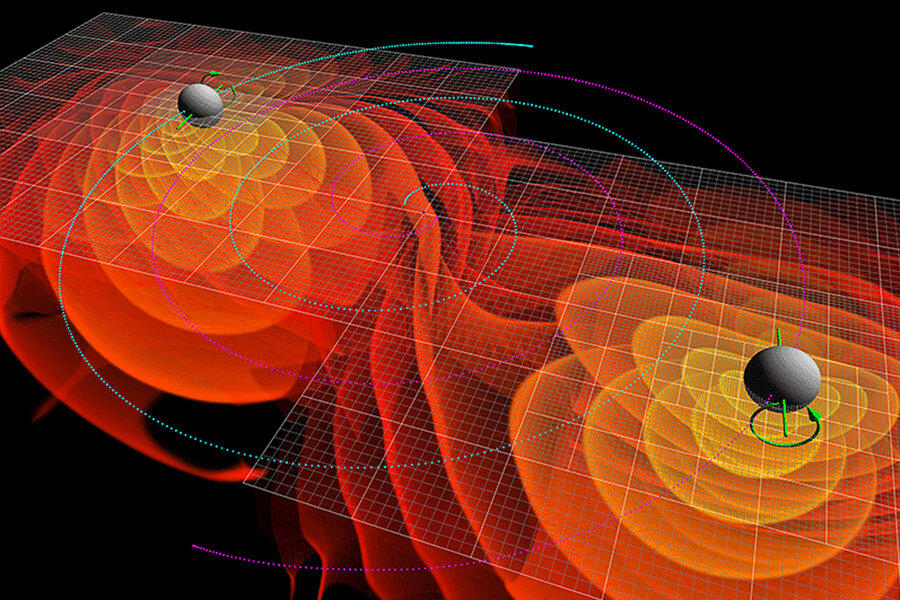Some 1.3 billion years ago, in a galaxy far, far away, two massive black holes collided violently, setting off ripples in the fabric of spacetime. These ripples, called gravitational waves, passed through Earth on Sept. 14, 2015. And for the first time ever, humans knew they arrived.
Albert Einstein’s general theory of relativity had predicted gravitational waves a century earlier, but it wasn’t until the Laser Interferometer Gravitational-wave Observatory (LIGO) was built at the turn of the 21st century that there was any chance of finding evidence of them.
LIGO found that evidence. And again, three months later. And again this past January. And again in August. Each of the four gravitational wave detections added further support for Einstein’s theory, ensuring that the LIGO team would go down in history.
Tuesday, that legacy was etched in gold, as the Royal Swedish Academy of Scientists awarded LIGO architects Rainer Weiss, Kip Thorne, and Barry Barish the 2017 Nobel Prize in Physics for their work designing, building, and using LIGO.
But these first four detections and the honor bestowed upon the scientists are just the beginning. LIGO’s success signals the beginning of a new kind of astronomy.
“This opens up a new window on the universe,” says Saul Teukolsky, a theoretical astrophysicist at Cornell University in Ithaca, N.Y. “And each time a new window has opened up, we’ve made incredible discoveries.”
Until now, astronomers have largely relied on electromagnetic radiation to observe the universe. Objects emit electromagnetic waves across a broad spectrum, some visible to the human eye as light, but all detectable by the telescopes currently in use on Earth or in orbit.
But gravitational waves allow astronomers to look at the universe in an entirely different way: through motion.
“Everything generates gravitational waves. You and I generate gravitational waves by opening our mouths and talking. Every time matter moves around, gravitational waves are generated,” explains Lawrence Krauss, a theoretical physicist and cosmologist at Arizona State University.
Just as electromagnetic radiation can travel in a spectrum of wavelengths, so do these gravitational ripples. Over centuries of telescope construction, astronomers have honed their ability to observe the universe across that electromagnetic spectrum, from radio waves to gamma rays. And now, astronomers aspire to build better and better detectors that can capture the full range of gravitational waves as well.
“This is a totally new type of astronomy,” says Manuela Campanelli, director of the Rochester Institute of Technology’s Center for Computational Relativity and Gravitation, in Rochester, N.Y.
And incorporating gravitational wave observations with data from existing techniques could revolutionize astronomy.
Multi-messenger astronomy, as it is known, offers astronomers insights into cosmic events dating back to the beginning of the universe. By combining data from electromagnetic radiation, gravitational waves, neutrinos, and cosmic rays, scientists can assemble detailed pictures of collisions of black holes, neutron stars, and other massive objects.
“There is a possibility of learning a lot of what’s going on about and around these sources,” Dr. Campanelli says, “because now you have many independent means to extract information.”
The spectacular fireworks of colliding neutron stars, for example, can currently be observed in electromagnetic wavelengths, so scientists know a bit about what they are made of, says Professor Teukolsky. But how they work, the nuclear physics of neutron stars, has yet to be determined. And gravitational waves might be able to add that key piece of information.
That’s because gravitational waves, unlike electromagnetic waves, are not absorbed by other objects as they pass through the universe, Teukolsky explains. So, with gravitational waves, he says, “we’re able to see things deep inside these violent explosions that are going on.”
Astronomers hope to answer questions about basic physics, nuclear physics, and continuous phenomena using gravitational waves propagating from collisions of massive objects such as black holes to the subtle ripples of steady motion in the universe. And, perhaps, gravitational waves will carry astronomers answers to questions about the origins of the universe itself.
Some of the discoveries that lie ahead could even be unfathomable for astronomers now.
“This is just the beginning of a whole new wave of astronomy,” Dr. Krauss says. “I can’t think of another time when we’ve opened up this vast new window and we haven’t been surprised. What else creates gravitational waves? What other cataclysmic events are there in the universe that we might observe? Who knows? That is the great thing about discoveries: they’re discoveries.”
Source: http://bit.ly/2hMm83F











